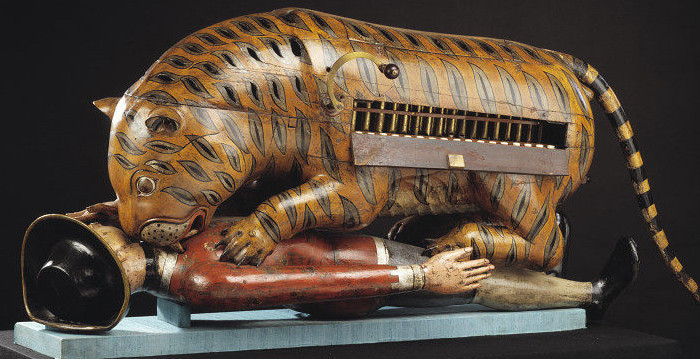Tipu’s Tiger
Theme: The arts in the Age of Revolution, Economic and technological revolution, Trade, tariffs and taxes
This is an almost life-size model of a tiger mauling a European solider. It was made for Tipu Sultan, who ruled Mysore in South India from 1782 to 1799. Tipu had two great passions, a fascination for tigers and a hatred of the British. The control of India by the British East India Company contributed greatly to Britain’s growing wealth, but Tipu was single-minded in the way that he sought to modernise the Mysore economy and fought hard to resist invasion.
Tipu Sultan successfully resisted British invasion three times.
In the late 1700s, the British East India Company, which had initially been set up to trade with India and China, was beginning to forcibly take over different areas of India. Indian textiles, spices, and other exports made a substantial contribution to the British economy, as raw materials were worked up by British manufacturers.
Tipu Sultan successfully resisted British invasion three times, preferring diplomatic relations with France. As part of their campaign to justify these invasions, the East India Company and British authorities vilified Tipu, representing him as a fanatical Muslim tyrant bent on persecuting Christians. They created propaganda about his links to Republican France, claiming that he planted liberty trees and set up a Jacobin Club (modelled on the French Revolution) in the late 1790s. He was eventually killed, as soldiers swept through Mysore’s capital, Seringapatum. India came under British rule in 1858.
After the defeat at Seringapatum, Tipu’s treasury was divided among the soldiers. But this tiger was shipped to London and displayed in the East India Company’s new ‘Indian Museum’. When the handle is turned, the soldier’s arm lifts up and down, covering his mouth; bellows inside the tiger make the sound of his ‘dying moans’. There is also an organ concealed inside the tiger behind a wooden flap, which can be played when the handle is turned.
Did you know..?
Colonel Arthur Wellesley (the Duke of Wellington) – who would later command the British army at the Battle of Waterloo, led British East India Company soldiers in the assault on Seringapatum. When houses were looted by the army, he restored order by hanging and flogging some of the men responsible.
Sources & acknowledgements
This object description and its related educational resources were researched and written by our team of historians and education specialists. For further information see the item’s home museum, gallery or archive, listed above.
-
Education overview
You can access a range of teachers resources related to this object and more on our education page.
Please also see our glossary of terms for more detailed explanations of the terms used.
-
Curatorial info
- Originating Museum: Victoria and Albert Museum
- Accession Number: 2545(IS)
- Production Date: ca. 1793
- Creator: Unknown
- Material: Painted wood with metal fixtures
- Creation Place: Mysore
- Size: Length: 178 cm, Height: 71 cm, Width: 61 cm
- Original record
-
Use this image
- Rights Holder: © Victoria and Albert Museum, London
- License Type: All Rights Reserved
Find it here
This object is in the collection of Victoria and Albert Museum







